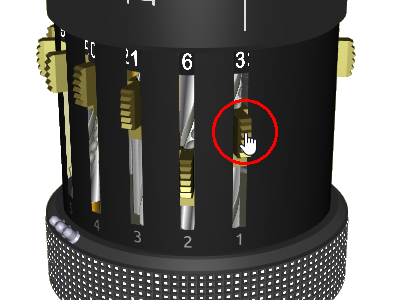
Drag the slider up or down with mouse button pressed.
Here 163 is entered on the setters.
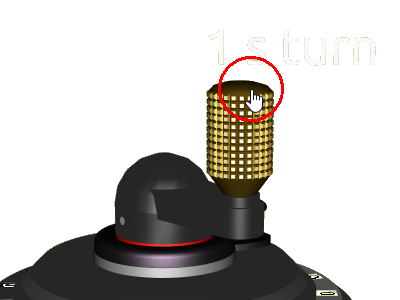
Click the crank handle to start a crank cycle.
The higher you click on the handle the faster the turn.
Speeds are 1, 3, 9 and 27 s
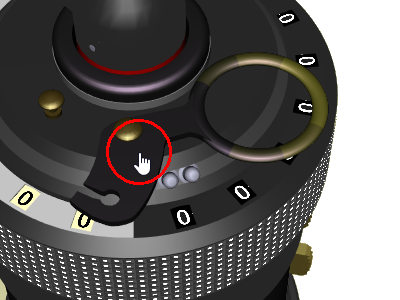
For easy use the clearing lever can be extended.
Click any part of the lever to extend it.
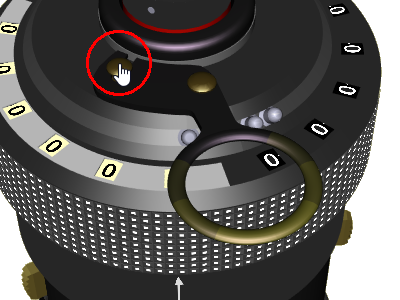
The clearing lever must be folded to store the Curta in the storage container.
Click the clearing lever position plunger to fold the lever.
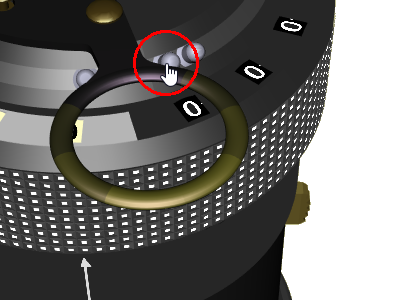
Click on any of the 4 colored section of the clearing lever ring to start a clearing action
Here we start a Very Slow Clearing Counter Clockwise (CCW))
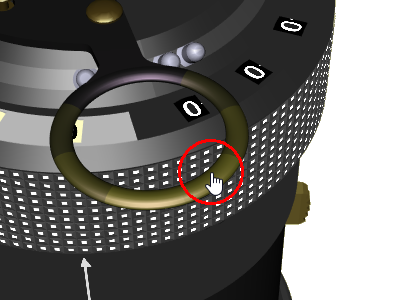
Click on any of the 4 colored section of the clearing lever ring to start a clearing action
Here we start a Very Fast Clearing Counter Clockwise (CCW))

Click the Crank handle to toggle the adder mode between Addition and Subtraction.
Here the adder mode is Addition
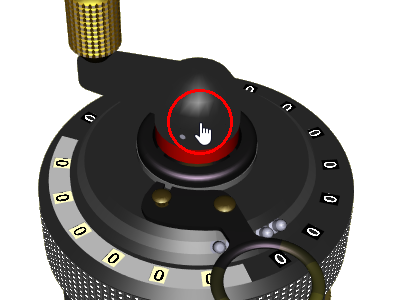
Click the Crank handle to toggle the adder mode between Addition and Subtraction.
Here the adder mode is Subtraction.
Note the red ring under the crank handle to indicate Subtraction mode.
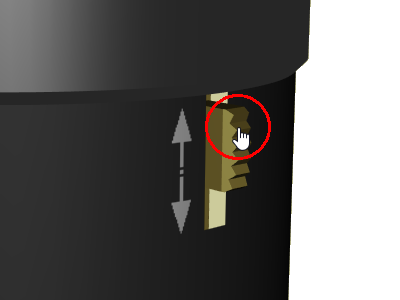
Drag the Reversing Lever up for Increment mode.
- A crank turn with the adder in Addition mode increments the Turns Counter
- A crank turn with the adder in Subtraction mode decrements the Turns Counter
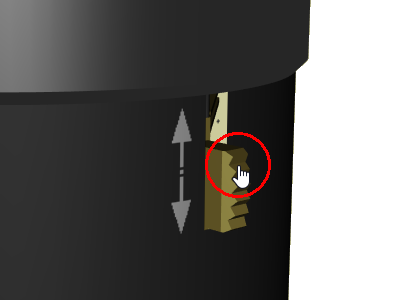
Drag the Reversing Lever down for Decrement mode.
- A crank turn with the adder in Addition mode decrements the Turns Counter
- A crank turn with the adder in Subtraction mode increments the Turns Counter
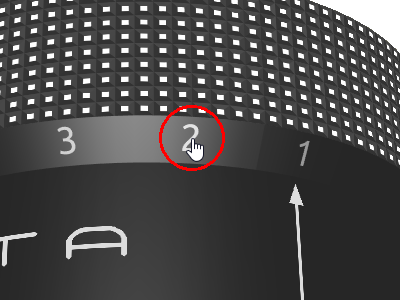
Click on the digits 1..6 on the underside of the carriage.
- 1 .. x 1
- 2 .. x 10
- 3 .. x 100
- 4 .. x 1000
- 5 .. x 10000
- 6 .. x 100000
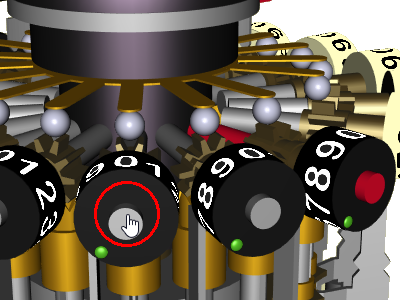
Click on the shaft to rotate it to the x 1 position.
Calulated as: 12345 x 298 = 12345 x 300 - 12345 x 2
This way only 5 crank turns are required.
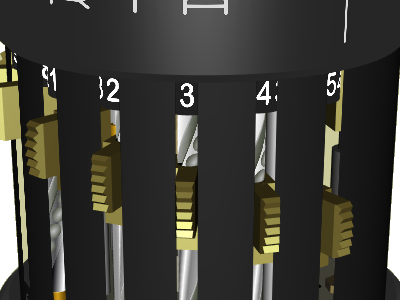
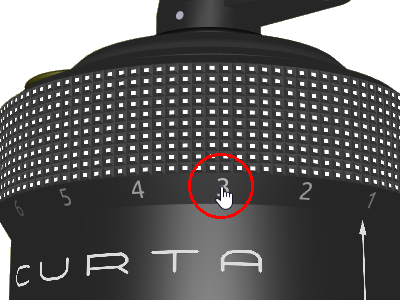
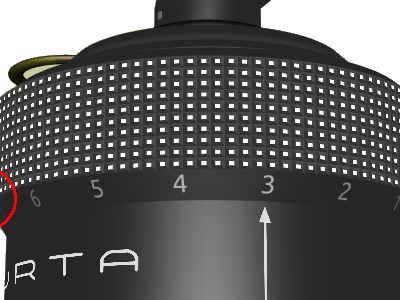
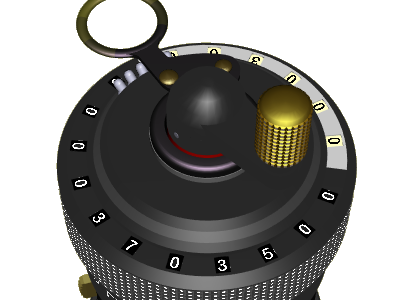

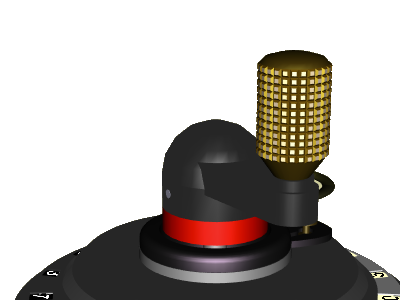
Done...

12345 x
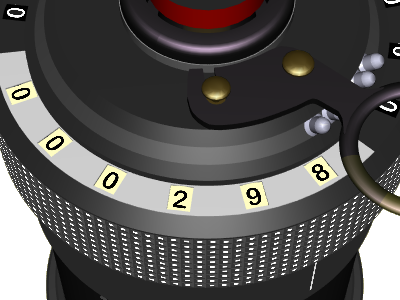
298
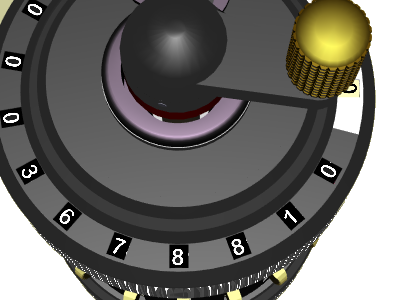
= 3678810
VRML: loading...
For two main reasons:
- To learn a little VRML programming
- Because I feel the Curta Calculator is a real beauty
My first exposure to the Curta was when a teacher showed us a Curta in our classroom.
It really was an amazing little machine. We were each allowed to do one easy calculation on the Curta.
That was early 1964, not long after JFK was killed in Dallas. The Royal Dutch Air Force crashed an F 104 Starfighter every few months and there was Robot Archie, a fictional comic character known in the Netherlands as Archie de Man van Staal.
Yes:
In the past everything was better... even the future.
...
>> Fast Forward 44 years >>
...
After searching the Internet for a while I discovered that it was called a Curta.
The good thing is that there is plenty of information on the Curta.
The bad thing is that they are now collectable.
Not willing to spend 1000+ dollars on the real thing I decided to build my own.
Because I do not like to get tired or dirty I soon settled for a virtual one.
I already did a few things in VRML, so it was a logical choice to use it for the Curta.
VRML 2.0 allows for basic animations, and for more complex things you can use JavaScript Nodes.
All you need is a PC, and a little time :-)
To get things done I decided not to
- make Power Point (TM) presentations
- write Word (TM) Document
- use TeamTrack (TM) (who needs it anyway)
- use ClearCase (TM) (an over engineered piece of shit)
- use Visio (TM) for drawings
- use a 3D tool or CAD program
but
- type in basic VRML code using the splendid VrmlPad editor
- draw with a pencil on paper
- use an eraser for corrections
and
- make it work (prove that it can be done)
- make it nice (refactoring code)
- make it fast (but only where it makes sense)
At first I used a lot of information from the Internet and a set of drawing of the outside of a Curta I from Rick Furr.
A lot of information came from the
Curta Disassembly.
When I had the basics in place I mailed Rick Furr the owner of The Calculator Reference a splendid website with a large section on the Curta
with a request for some measurements.
Over the next months I received every measurement I asked for and lots of suggestions too.
Rick measured many of his Curta parts and also sent photographs of all the details.
From then on it was a matter of stepwise refinement
- fix a few mistakes
- call other mistakes features
- add another part or two
- think of a new gimmick
and the result is
- 70 .wrl files with the actual VRML worlds (total: 118 kB)
- 1 main file of 8 kByte
- 69 prototype files between 1 kB and 5 kB each
- 15 images texture files (total: 227 kB)
- 2 x image texture for settings wheels (hi and lo-resolution)
- 2 x image texture for results wheels adder (hi and lo-resolution)
- 2 x image texture for results wheels turns counter (hi and lo-resolution)
- 1 x image texture for base (bottom) plate
- 1 x image texture for the colar
- 1 x image texture for the indentations in the settings shaft of 12 kB
- 3 x image texture for color settings wheels (3 kB each)
- 1 x image texture for the reversing lever shaft
- 1 x image texture for the body (standard)
- 1 x image texture for the body (with color setters)
- 12 wave files for the sounds (total: 619 kB)
Now that the BS Contact viewer is no longer available for free download it was time to move to another viewer.
The X_ITE viewer works with WebGL and works on most modern browsers.
It is free, there is no flying saucer and it doesn't expire.
Best of all there is nothing to download and install.
Rick Furr is the owner of
The Calculator Reference a splendid website with
a large section on the Curta.
He measured a lot of Curta parts, tested the model and mailed a lot of suggestions and photos.
The Posters you can order on his page are a must have for every Curta Collector.
For my daily reminder that a Curta simulation is a completely pointless exercise.
No better motivation to continue!
Imagine that it was a real project... With meetings, a plan, reviews and a boss...
But to be fair, he certainly had a few perfect suggestions. When I find time...
For proof reading everything and finding 28 errors in 8 files.
Over the years I received several mails requesting to use the files of YACS for 3D printing projects.
There are several reasons why the YACS files are NOT a good starting point for a 3D Curta project.
- YACS is handcoded VRML and JavaScipt
- Much of the VRML is created with JavaScript
- Many of the parts that make up the Curta are not present in YACS
- The dimensions are from measuring a real Curta
- Some dimensions are changed to make it work
A full set of the original engineering drawings for the Curta Calculators is available thanks to the curator of the MuseumMura in Mauren, Liechtenstein.
To download the drawings
- Go to the site of MuseumMura
- In the second row of pictures scroll right to Legendäre Technik with the picture of the Curta
- Click the Picture of the Curta
- Select Curta Rechenmaschine in the menu bar
- On the Curta Rechenmaschine page scroll down to the end
- In the box Download ...
- You see curta_1_engineering_drawings.zip and a lot more...
info@satadorus.eu




















